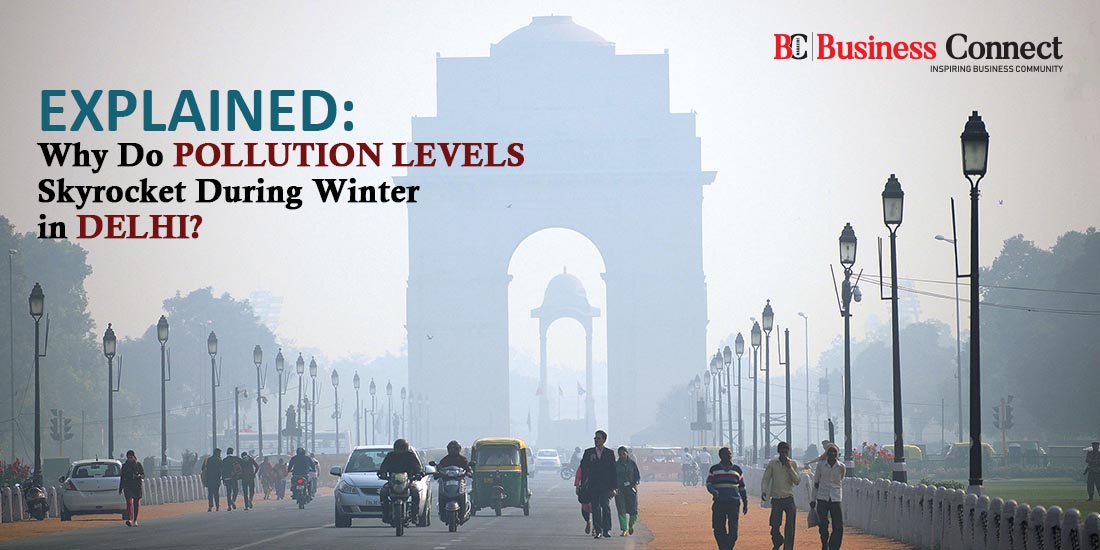Explained: Why Do Pollution Levels Skyrocket During Winter in Delhi?
Globally, air pollution is a matter of concern. When it comes to decreasing air quality in winter, India has been the focus of attention in recent years. Every year as winter approaches, the air quality deteriorates. Smog causes practically all of the metros, not just Delhi, to choke.
In 2016, India rated 141 out of 180 on the Environment Performance Index (EPI). Excessive levels of air pollution are caused mostly by the combustion of garbage, biomass, and crop residue, particularly in the winter. However, why does the air quality degrade faster during the winter? We need to find the answer to it.
Is winter pollution only an Indian Problem?
No, winter pollution is a worldwide phenomenon that originally made news during the Great London Smog of 1952. The Smog, which killed approximately 12000 Londoners, shocked Britain and the rest of the world. Because it was mostly caused by excessive coal burning following a particularly cold winter, the fallout pushed Britain to impose stronger air quality standards.
China has been dealing with winter pollution for decades, notably in its northern cities. However, in recent years, it has mandated emission reductions for industries and families during the winter, and experts say these measures are beginning to bear fruit.
One of China’s major concerns, like India’s, is regulating levels of PM2.5 (fine particulate matter with a diameter of up to 2.5 millimetres), which can be lethal in high numbers. China and India account for more than half of the 41 lakh PM2.5-related deaths worldwide in 2016.
How Dipping Temperature Increases Air Pollution?
Throughout the year, air pollution is a problem. In fact, in the previous summer, metros such as Delhi did not enjoy a single day of decent air quality. However, as a result of weather circumstances and human activities, pollution levels rise after Diwali, particularly in North Indian regions.
Winter inversion and the valley effect, as well as industrial and vehicular emissions, are some of the causes of increased winter air pollution. Dust storms, crop fires, the use of solid fuels for heating, and Diwali-related pollution all contribute to winter pollution.
What exactly is a Winter Inversion?
The lowest layer of the atmosphere is warmer and lighter in the summer than in the winter, making it easier for air to move upwards. Pollutants are thus transported away from the ground as a result. During the winter, however, the air near the earth’s atmosphere is denser and cooler.
Inversion occurs when warm air confines cool air, forming a kind of atmospheric lid. Within this layer, there is vertical mixing of air, which causes contaminants to diffuse back into the atmosphere. Night time inversion effects are significant, and as a result, the quality of the air decreases. Because of the high levels of pollution in the morning, experts recommend avoiding morning walks and morning workouts.
Major Factors that Affect Delhi’s Air
1. Weather
Winter inversion is a phenomenon that affects Delhi, nearby cities, and all of northern India. Pollution levels rise as a result of the pollutants becoming “stuck” and continuing to accumulate. Because North India is landlocked, this combination of weather and pollution causes smog every year.
Therefore, the winter pollution scenario in Delhi, the National Capital Region, and the entire northern India region at this time is nothing new.Emergency measures might not be as effective and might even backfire. People will be left stranded if cars are stopped, which might actually hinder the city’s ability to operate normally. Long-term infrastructural development is necessary, according to Roy Chowdhury,Executive Director of Research and Advocacy, Centre for Science and Environment.
2. Industry:
Although Delhi’s coal-based power facilities have been shut down, their neighbours’ cities still run coal-based power plants. Furthermore, troubled regions like Sonipat and Ghaziabad continue to be industrial areas. According to Roy Chowdhury, a long-term solution to Delhi’s pollution problem is a pipe-dream because the city’s pollution cannot be considered as isolated as long as its surrounding industrial districts don’t clean up.
3. Crop burning
The NCR is experiencing a high in construction activity, with housing and development projects centred in its outlying cities, which affects the year-round PM10 component of air quality.
However, Haryana and Punjab’s seasonal crop burning raises PM 2.5 levels and puts the city in danger each winter. “This year, crop burning wasn’t a huge problem at first because it rained in October. However, the crop burning problem reached its apex in early November. On November 6, 48% of Delhi’s air pollution came from burning crops.
Currently, the yearly crop burning that takes place for 20 days contributes to the local environmental issues, and until long-term solutions are discovered, emergency measures may not be successful. The government’s initiatives on clean fuel and other initiatives have helped lower Delhi’s average annual air pollution levels, but more targeted action is needed to address the winter problem, according to Roy Chowdhury.
4. Cars:
Delhi still lacks a mass transportation system to meet the needs of its people. Additionally, there are lots of private vehicles there. There won’t be a long-term solution to the city’s traffic pollution any time soon until the users of private vehicles switch to mass transportation.
“Delhi and the nearby cities require a robust public transportation system. Delhi has 1.3 million vehicles. Industry, vehicles, and construction all contribute to Delhi’s pollution, but cars continue to be a major problem, according to Roy Chowdhury.
Must Read:-
- Top 10 Young Entrepreneurs in India 2022
- Upcoming Indian Web Series for 2022-23
- Top 10 Hospitals in India 2022
- Top 10 richest player of the world 2021
- Top 10 highest-paid Indian Athletes 2021
- Top 10 highest paid CEO in the World
- Top 10 richest person of India
- Top 10 Highest Paid CEOs of India
- List Of Most Followed Facebook Pages in 2022
- The Success Story of Jeff Bezos


